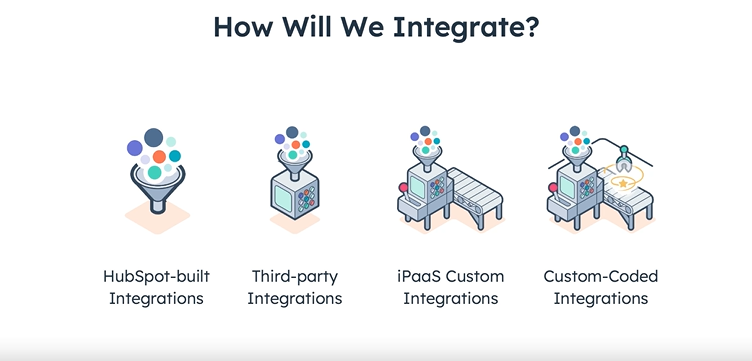Key integrations for your marketing in HubSpot
If you're reading this article, you probably already know what integration is and how it can help simplify processes, optimize efforts, and achieve...
By Role
By Industry
By Target Customer
What We Offer
We drive business growth by improving operational efficiency through process optimization, smart automation, and cost control. Our approach boosts productivity, reduces expenses, and increases profitability with scalable, sustainable solutions
Customer Experience
We design memorable, customer-centered experiences that drive loyalty, enhance support, and optimize every stage of the journey. From maturity frameworks and experience maps to loyalty programs, service design, and feedback analysis, we help brands deeply connect with users and grow sustainably.
Marketing & Sales
We drive marketing and sales strategies that combine technology, creativity, and analytics to accelerate growth. From value proposition design and AI-driven automation to inbound, ABM, and sales enablement strategies, we help businesses attract, convert, and retain customers effectively and profitably.
Pricing & Revenue
We optimize pricing and revenue through data-driven strategies and integrated planning. From profitability modeling and margin analysis to demand management and sales forecasting, we help maximize financial performance and business competitiveness.
Digital Transformation
We accelerate digital transformation by aligning strategy, processes and technology. From operating model definition and intelligent automation to CRM implementation, artificial intelligence and digital channels, we help organizations adapt, scale and lead in changing and competitive environments.
Operational Efficiency
We enhance operational efficiency through process optimization, intelligent automation, and cost control. From cost reduction strategies and process redesign to RPA and value analysis, we help businesses boost productivity, agility, and sustainable profitability.
Customer Experience
Marketing & Sales
Pricing & Revenue
Digital Transformation
Operational Efficiency
Discover the essential fundamentals for integrating apps in HubSpot. Define the step-by-step objectives and parameters of your integration projects.
Integrating applications into your company's HubSpot platform can significantly increase productivity and improve the experience and potential of the different action modules of your CRM, such as the Marketing Hub, Sales Hub, Service Hub, CMS Hub, and Operations Hub. In addition to these benefits, through native integrations, integrations from the marketplace, or custom developments, HubSpot will be able to streamline and automate different business processes within your CRM, as well as the efforts of your teams.
However, not all applications are the same, and not all integrations are easy. To ensure that your application, platform, or system integration project integrations are successful, you must understand the essential fundamentals of integrating applications in HubSpot.
This article will address the main factors your company should consider before integrating applications within HubSpot, such as Recommendations, needs and objectives diagnosis, requirements definition, vetting process, execution plan, and the integration testing and optimization process.
We will now address this article in the following areas:
Before consolidating an integration between complex systems, it is necessary to comprehend HubSpot's most basic and primordial elements: objects, records, and properties. These elements give life to the CRM, nurture the information, and make it flow between powerful software modules such as the Marketing Hub, Sales Hub, Service Hub, CMS Hub, and Operations Hub. Let's start by understanding them one by one:
Within HubSpot, there are multiple types of the elements mentioned above, but what are some of these types and their respective functions?
Let's start by understanding the functions of an object in HubSpot. As such, standard objects have the following purposes:
What should we understand by fundamentals to integrate? Each platform is different, works in different ways, and has components that may or may not adapt in the best way to our company's business model. What happens when our company has multiple independent digital channels or applications?
The answer for many companies will be: "We need to integrate them into one" or have another platform or application that can collect all those contact points with customers, suppliers, and our team in a single unified system such as HubSpot.

Image provided by HubSpot.
As visualized in the previous image, there are four different types of approaches for integration strategies for systems, applications, and tools of various kinds within HubSpot:
The following are the essential fundamentals you should consider to integrate applications and platforms into HubSpot successfully and how you should view them from a needs and objectives diagnostic:
Contextualization of data models and APIs.
For business processes and complex integrations between systems, it is necessary to understand how data flows within a platform, in this case, HubSpot. Now I'll give you a broader perspective on understanding the timing of existing data models in HubSpot and its APIs. How to understand the value of understanding HubSpot's data models and API logic? Understanding the intricacies of HubSpot's data models and API logic has several advantages, which I would recommend addressing as follows:
Lessons Learned from HubSpot's Data Integration and Data Model and API Architecture Certifications
It is not always simple to take the lead in integration projects; in many occasions, this kind of project in companies is only sometimes led by the technology department; many times, it is usually the same managers with another type of nature.
Despite this, HubSpot is more than just a CRM platform that can be purchased and ready to go. It also has a whole academic program full of courses, certifications, and accreditations that help companies nurture them with knowledge in different business areas, use of the additional software it provides, and many others you can find in HubSpot Academy.
Among the certifications, I share two incredibly enriching ones within this article as they are related and address the step-by-step processes and integration projects: The HubSpot Data Integration Certification and the HubSpot Architecture, Data Models, and APIs Certification. We recommend the following aspects:
HubSpot Data Integration Certification:
HubSpot Architecture I: Data Models and APIs:
Suppose you want to tackle complex integration projects in your company but need help figuring out where to start, or if you are clear, you need the expertise and human capital for this. Imagineer will be happy to help you, you can schedule a session with our consulting team, and we will add value to your processes, project, and, most importantly, your company.

If you're reading this article, you probably already know what integration is and how it can help simplify processes, optimize efforts, and achieve...

Did you know that you can use the HubSpot API to access very specific data in your account in a secure way? You can do this with HubSpot's Private...

I would like to invite you to test how the integrations between a CRM and a marketing automation platform work, for this, I must first tell you what...